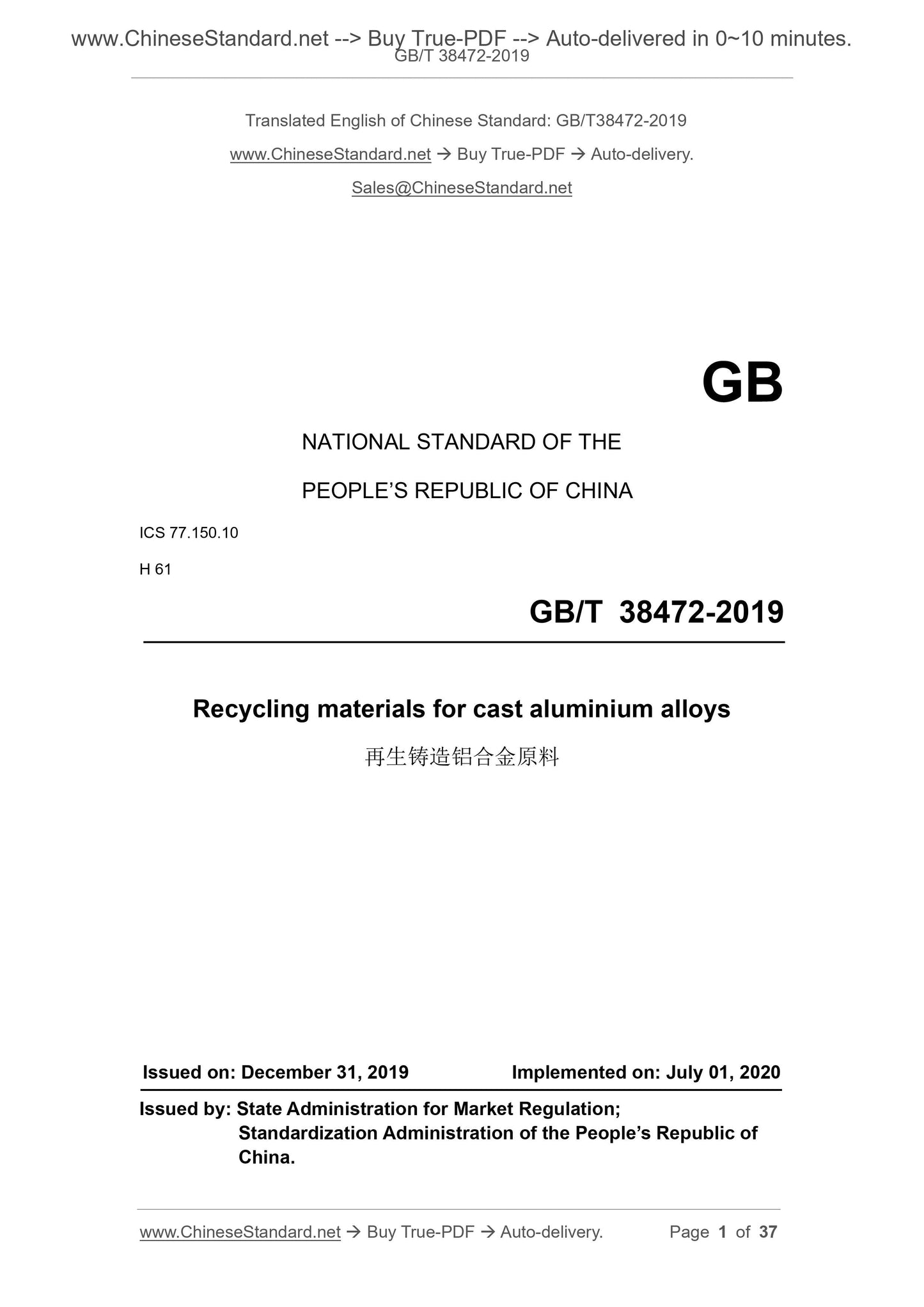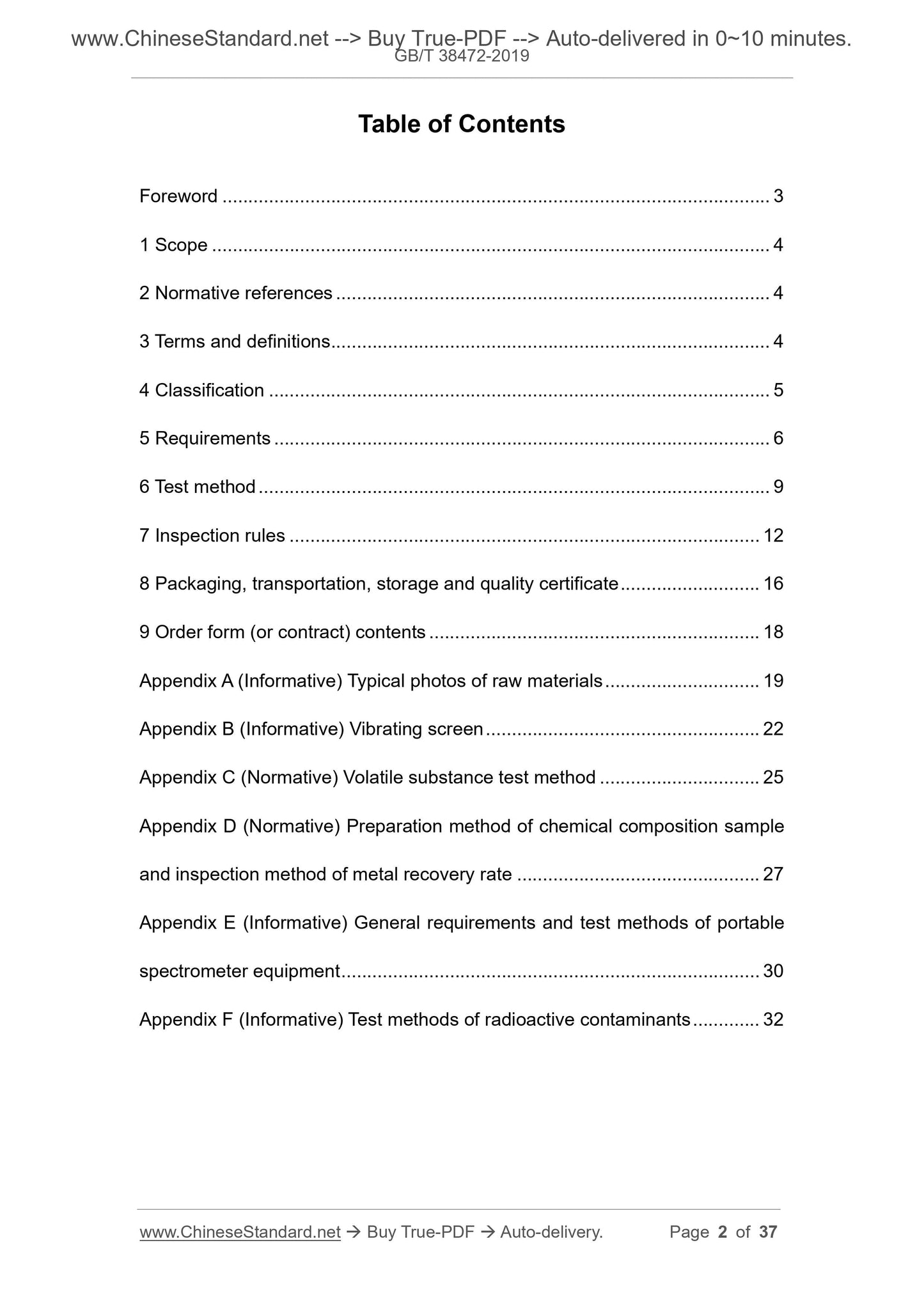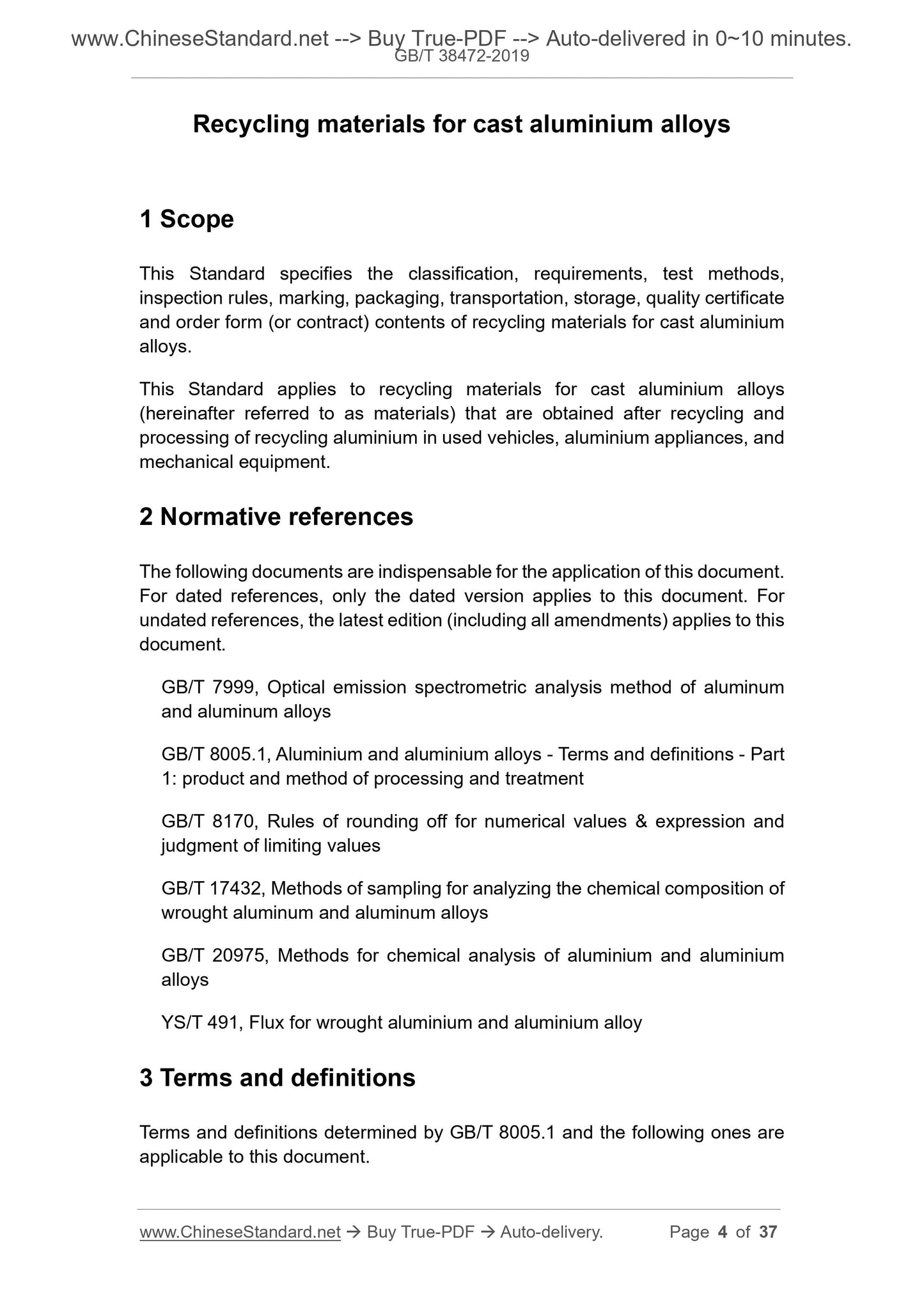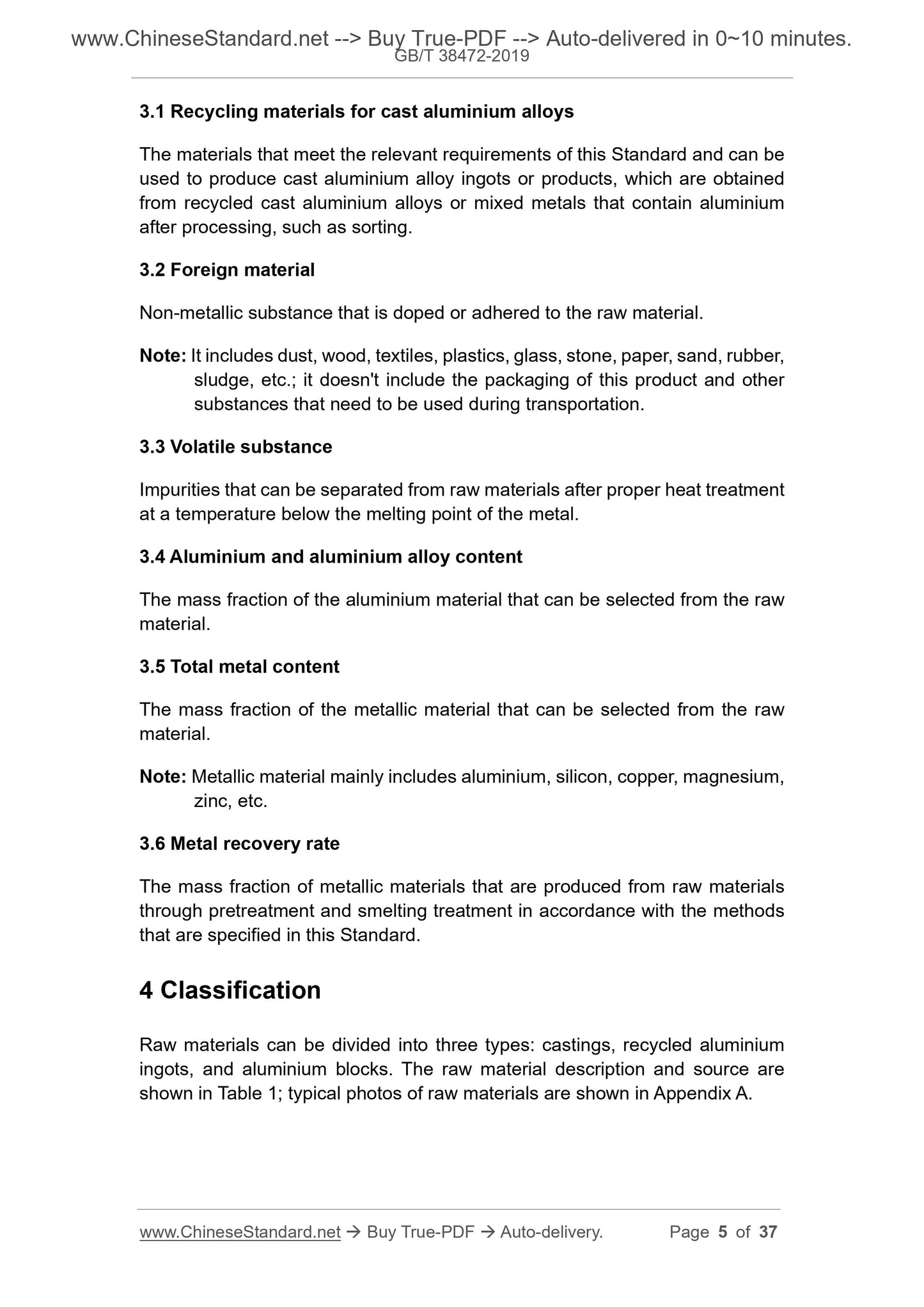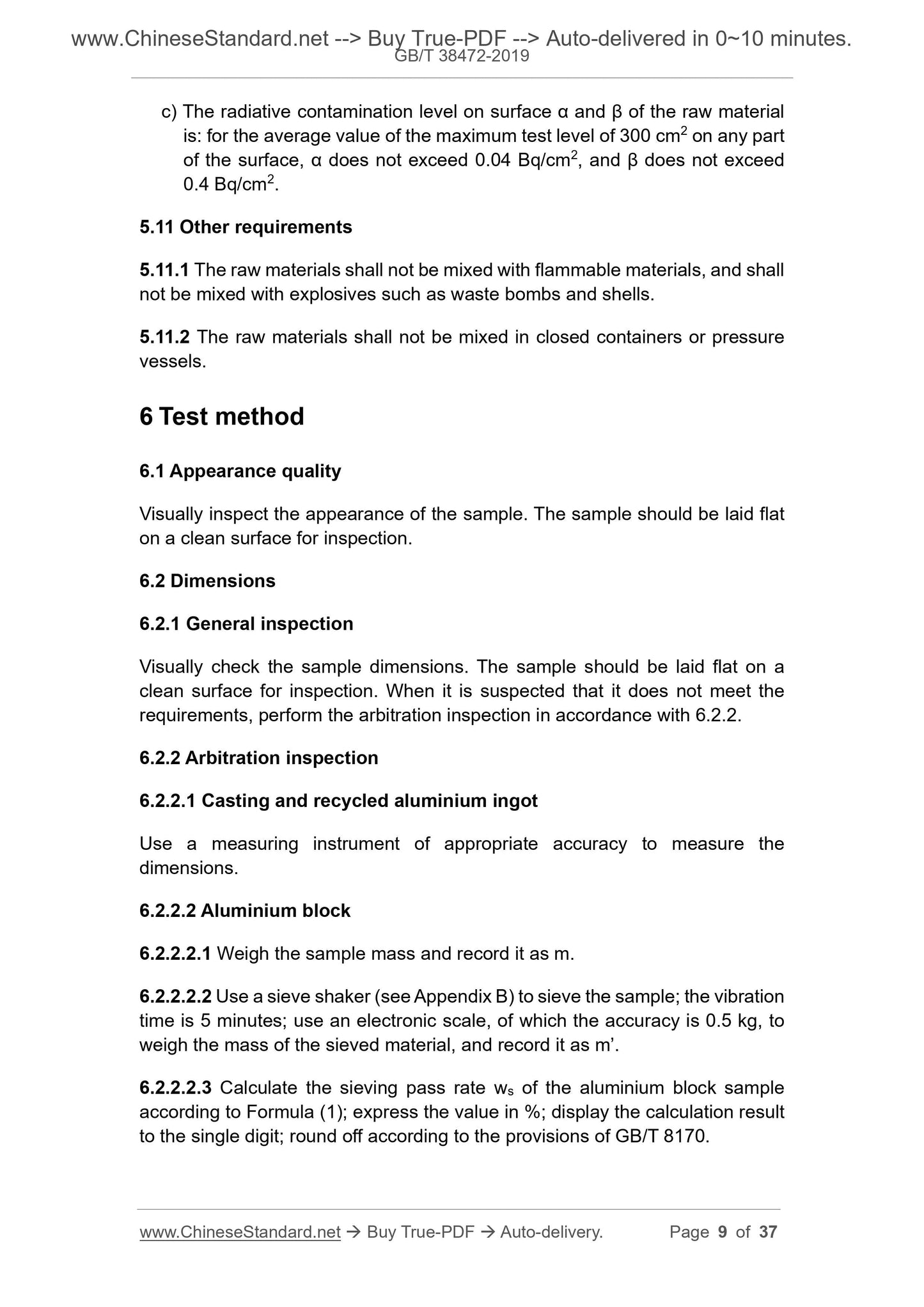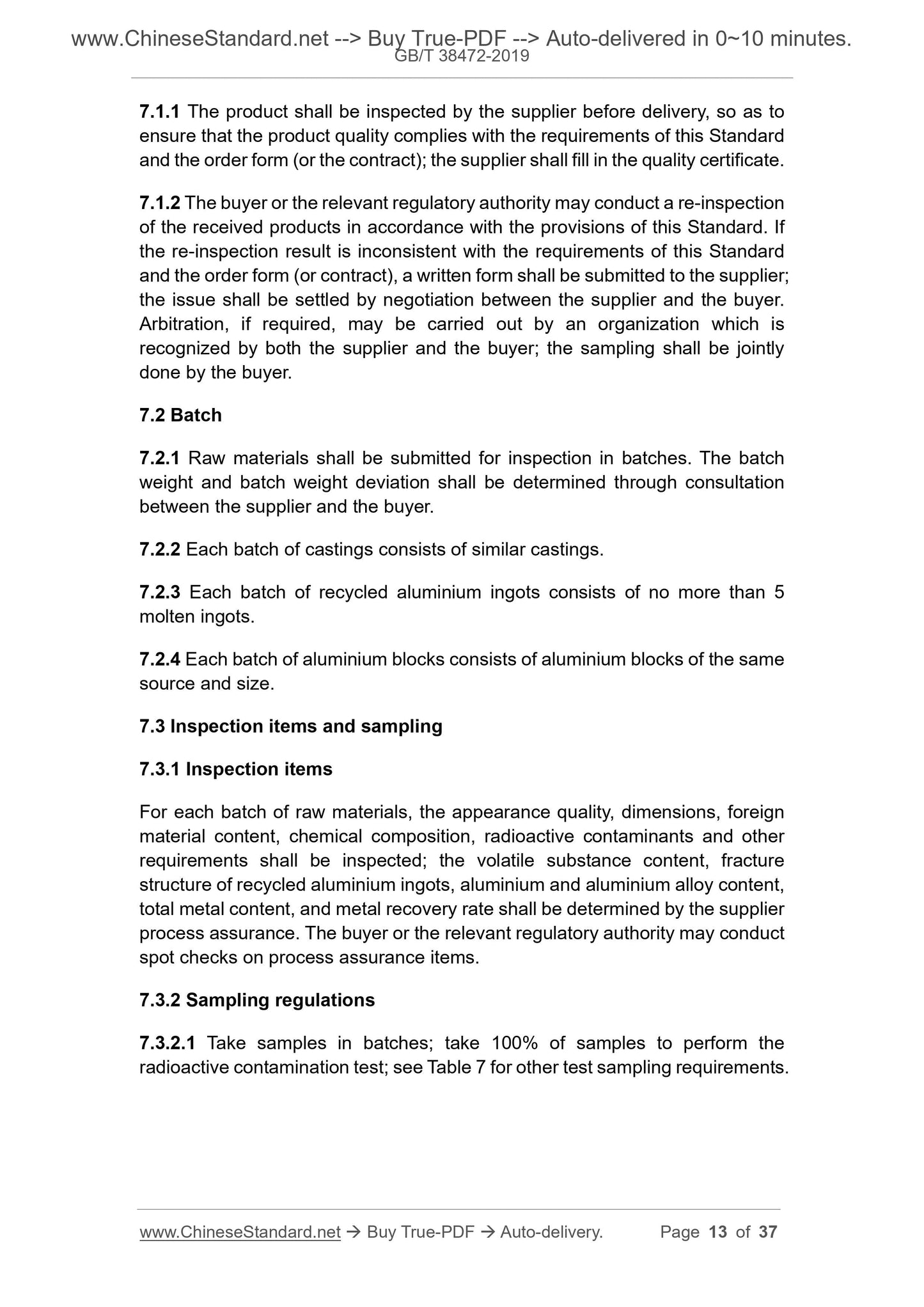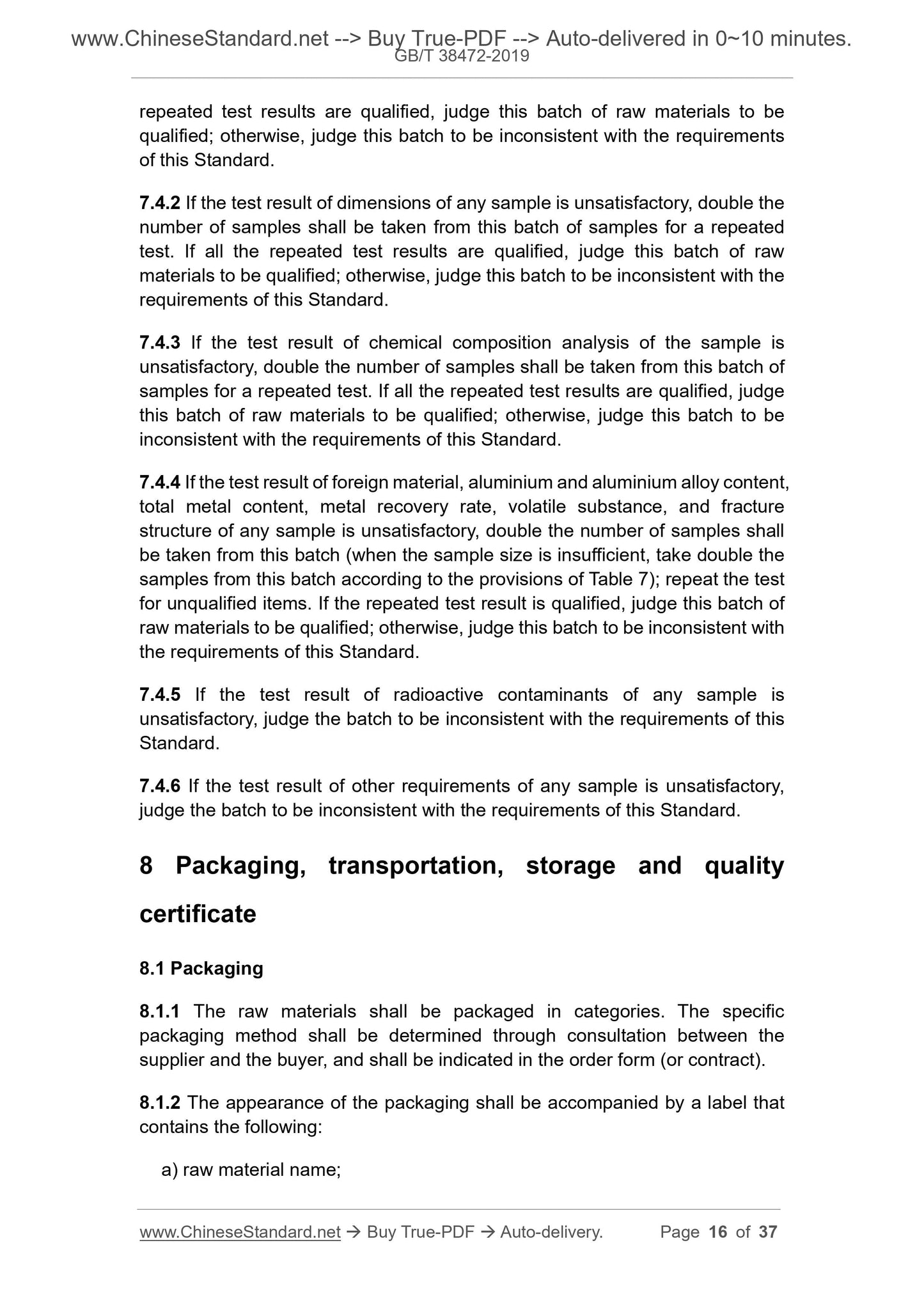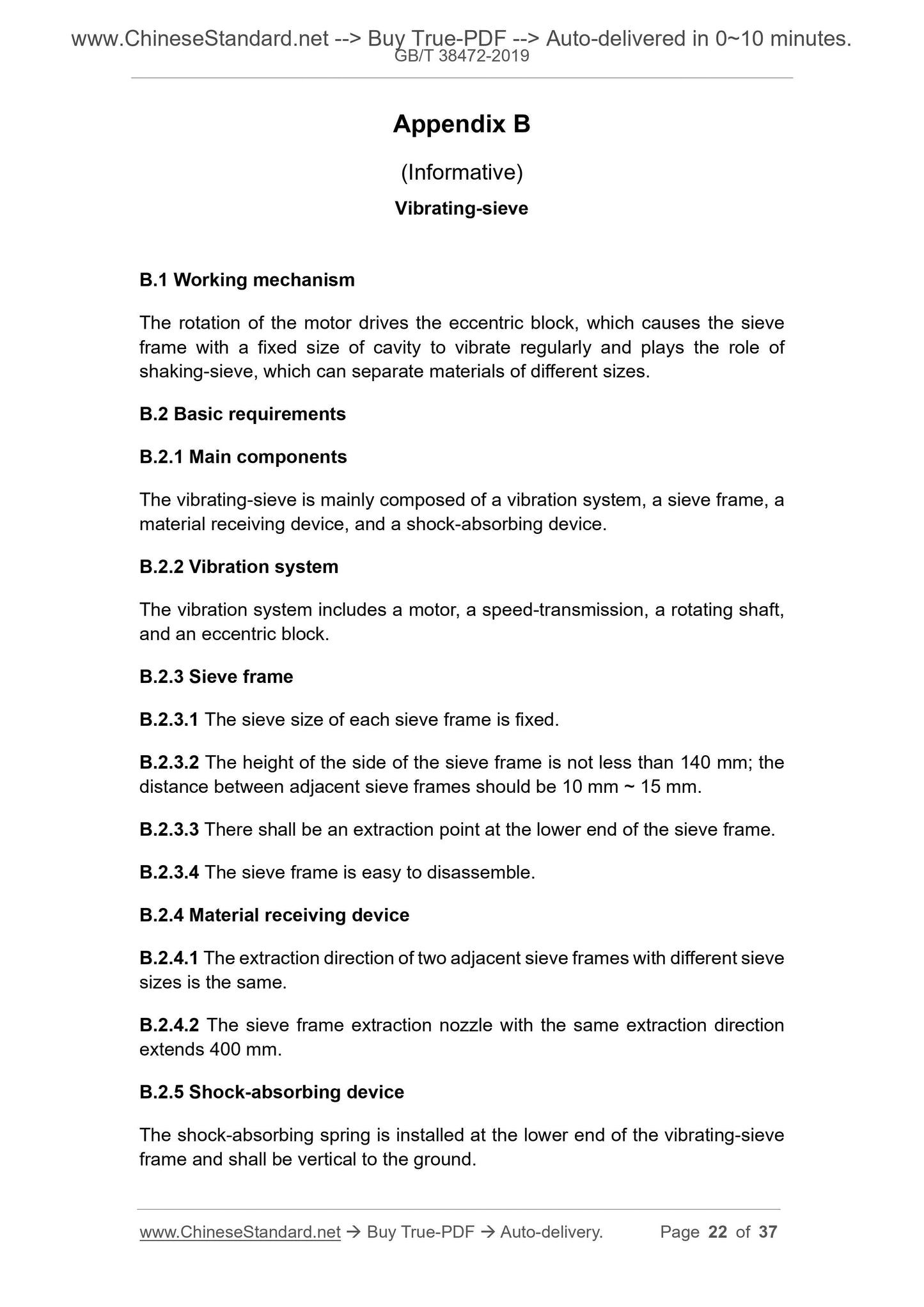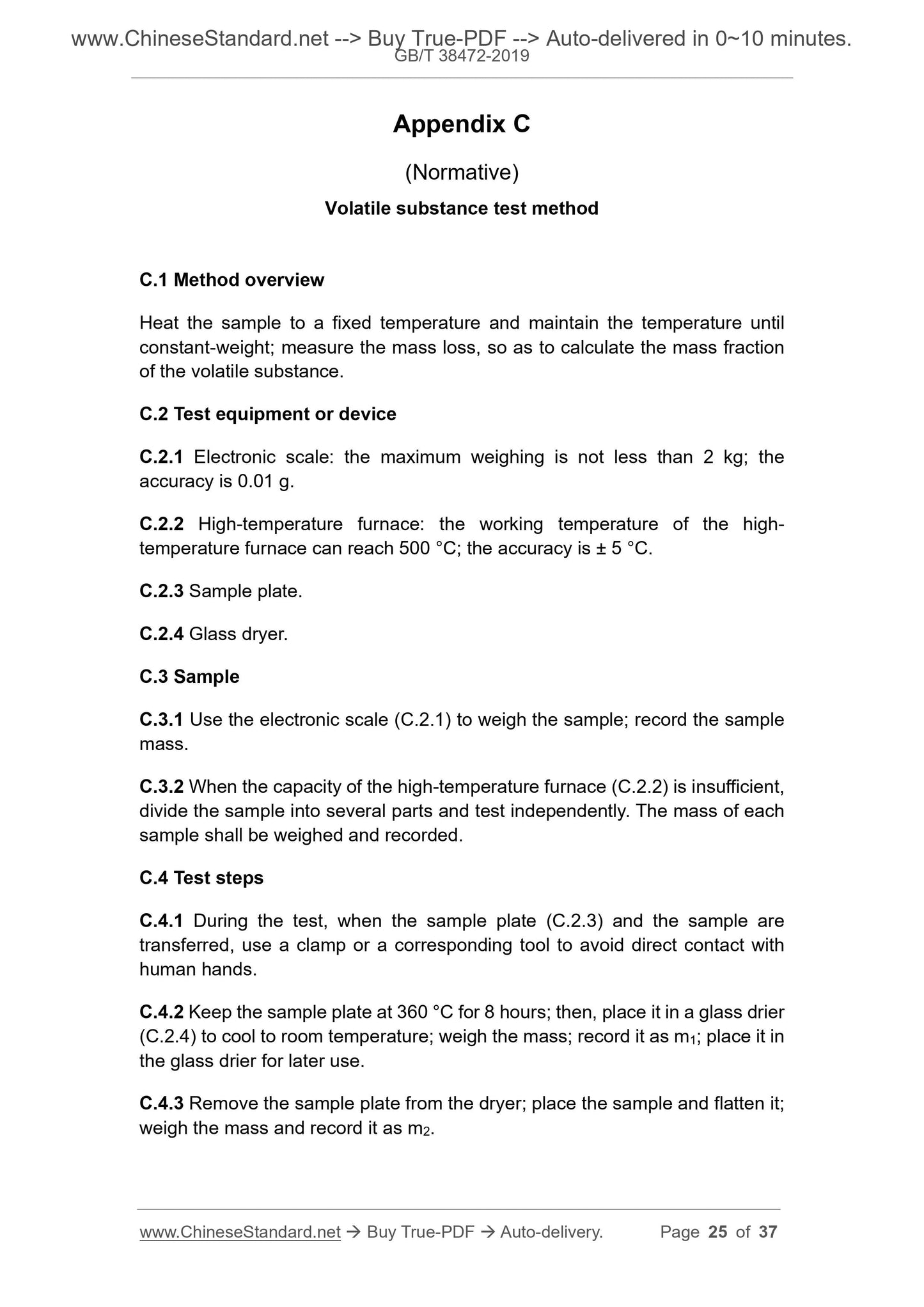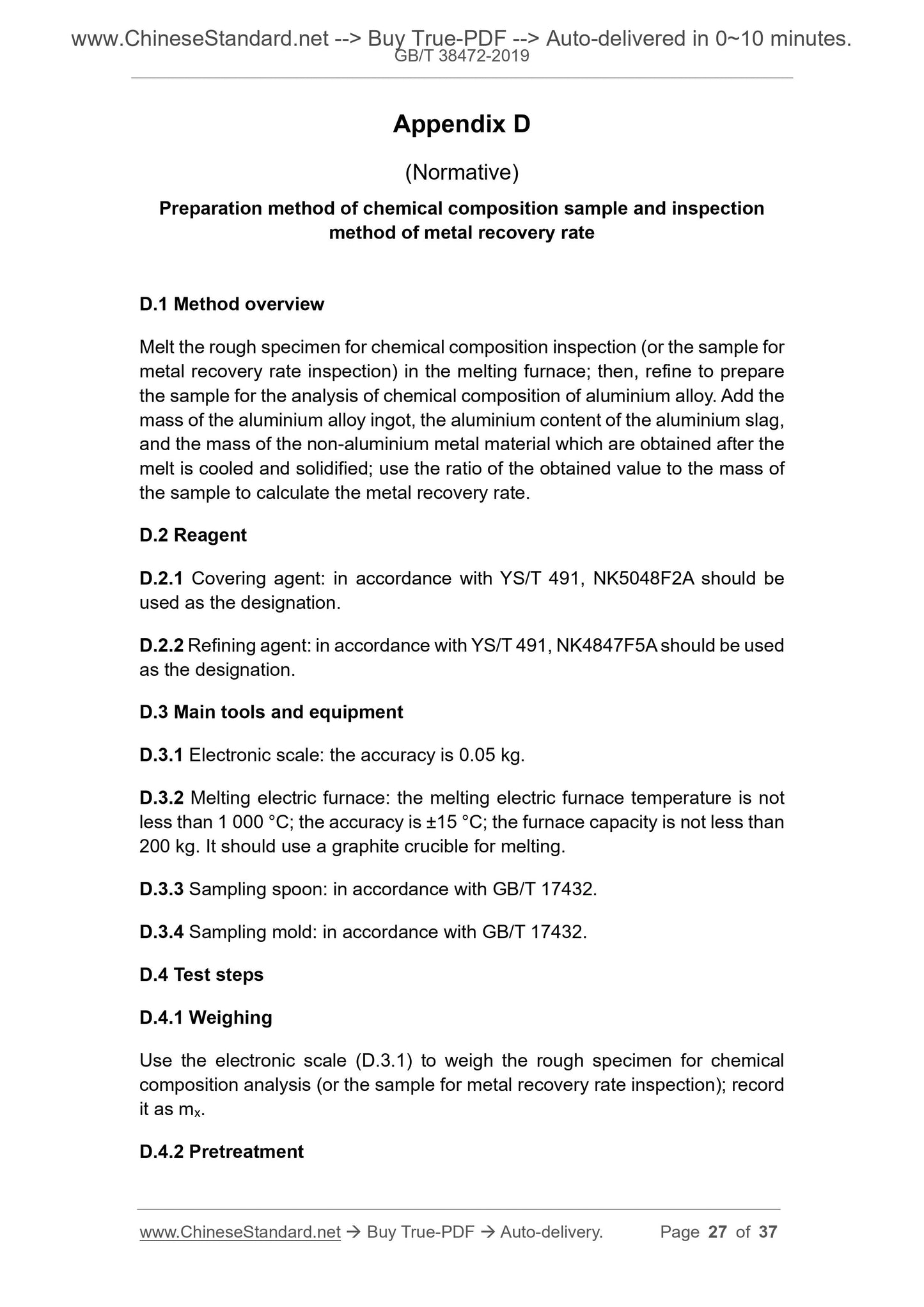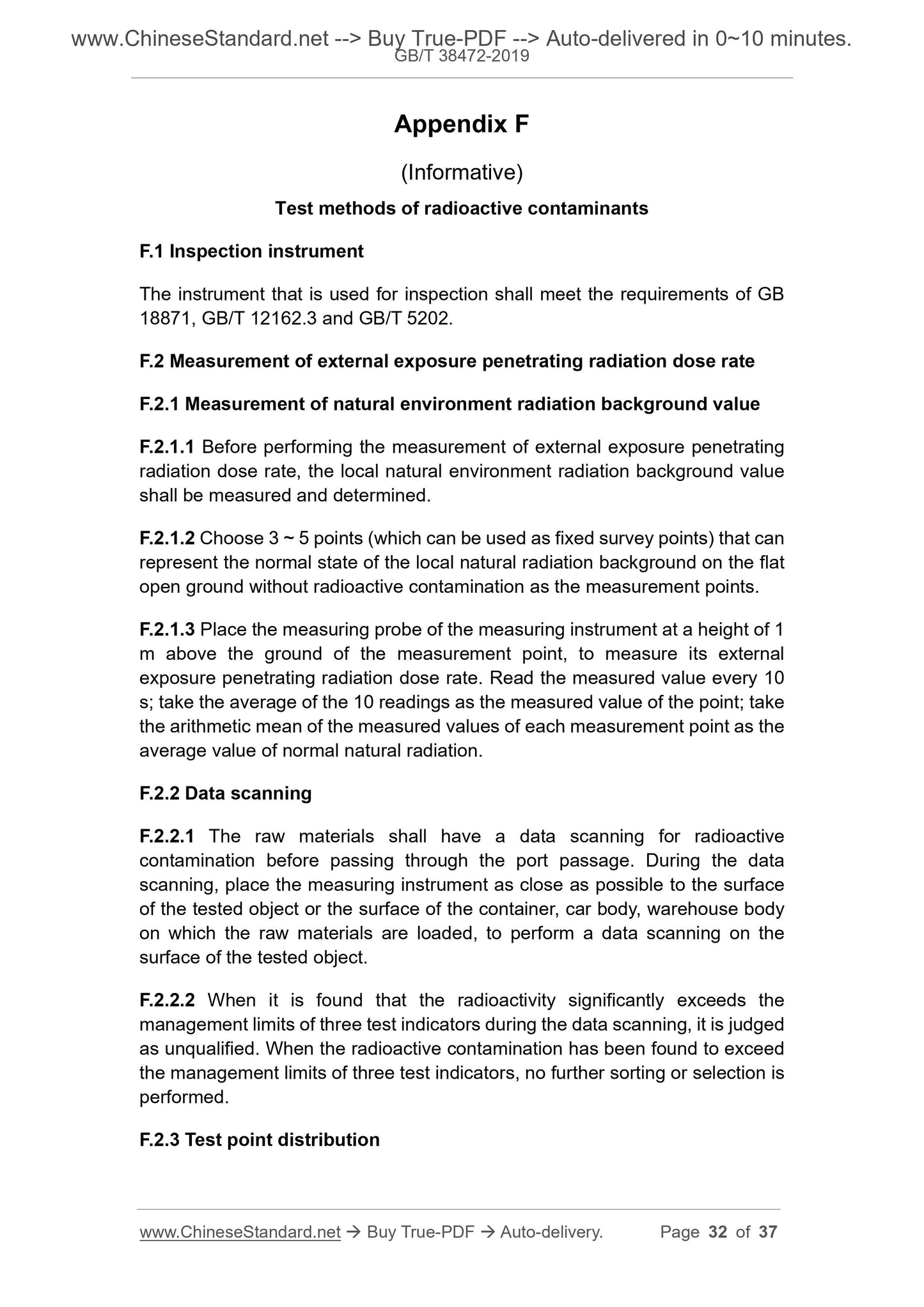1
/
of
11
PayPal, credit cards. Download editable-PDF and invoice in 1 second!
GB/T 38472-2019 English PDF (GB/T38472-2019)
GB/T 38472-2019 English PDF (GB/T38472-2019)
Regular price
$270.00 USD
Regular price
Sale price
$270.00 USD
Unit price
/
per
Shipping calculated at checkout.
Couldn't load pickup availability
Delivery: 3 seconds. Download true-PDF + Invoice.
Get QUOTATION in 1-minute: Click GB/T 38472-2019
Historical versions: GB/T 38472-2019
Preview True-PDF (Reload/Scroll if blank)
GB/T 38472-2019: Recycling materials for cast aluminium alloys
GB/T 38472-2019
NATIONAL STANDARD OF THE
PEOPLE’S REPUBLIC OF CHINA
ICS 77.150.10
H 61
Recycling materials for cast aluminium alloys
ISSUED ON: DECEMBER 31, 2019
IMPLEMENTED ON: JULY 01, 2020
Issued by: State Administration for Market Regulation;
Standardization Administration of the People’s Republic of
China.
Table of Contents
Foreword ... 3
1 Scope ... 4
2 Normative references ... 4
3 Terms and definitions ... 4
4 Classification ... 5
5 Requirements ... 6
6 Test method ... 9
7 Inspection rules ... 12
8 Packaging, transportation, storage and quality certificate ... 16
9 Order form (or contract) contents ... 18
Appendix A (Informative) Typical photos of raw materials ... 19
Appendix B (Informative) Vibrating screen ... 22
Appendix C (Normative) Volatile substance test method ... 25
Appendix D (Normative) Preparation method of chemical composition sample
and inspection method of metal recovery rate ... 27
Appendix E (Informative) General requirements and test methods of portable
spectrometer equipment ... 30
Appendix F (Informative) Test methods of radioactive contaminants ... 32
Recycling materials for cast aluminium alloys
1 Scope
This Standard specifies the classification, requirements, test methods,
inspection rules, marking, packaging, transportation, storage, quality certificate
and order form (or contract) contents of recycling materials for cast aluminium
alloys.
This Standard applies to recycling materials for cast aluminium alloys
(hereinafter referred to as materials) that are obtained after recycling and
processing of recycling aluminium in used vehicles, aluminium appliances, and
mechanical equipment.
2 Normative references
The following documents are indispensable for the application of this document.
For dated references, only the dated version applies to this document. For
undated references, the latest edition (including all amendments) applies to this
document.
GB/T 7999, Optical emission spectrometric analysis method of aluminum
and aluminum alloys
GB/T 8005.1, Aluminium and aluminium alloys - Terms and definitions - Part
1: product and method of processing and treatment
GB/T 8170, Rules of rounding off for numerical values and expression and
judgment of limiting values
GB/T 17432, Methods of sampling for analyzing the chemical composition of
wrought aluminum and aluminum alloys
GB/T 20975, Methods for chemical analysis of aluminium and aluminium
alloys
YS/T 491, Flux for wrought aluminium and aluminium alloy
3 Terms and definitions
Terms and definitions determined by GB/T 8005.1 and the following ones are
applicable to this document.
3.1 Recycling materials for cast aluminium alloys
The materials that meet the relevant requirements of this Standard and can be
used to produce cast aluminium alloy ingots or products, which are obtained
from recycled cast aluminium alloys or mixed metals that contain aluminium
after processing, such as sorting.
3.2 Foreign material
Non-metallic substance that is doped or adhered to the raw material.
Note: It includes dust, wood, textiles, plastics, glass, stone, paper, sand, rubber,
sludge, etc.; it doesn't include the packaging of this product and other
substances that need to be used during transportation.
3.3 Volatile substance
Impurities that can be separated from raw materials after proper heat treatment
at a temperature below the melting point of the metal.
3.4 Aluminium and aluminium alloy content
The mass fraction of the aluminium material that can be selected from the raw
material.
3.5 Total metal content
The mass fraction of the metallic material that can be selected from the raw
material.
Note: Metallic material mainly includes aluminium, silicon, copper, magnesium,
zinc, etc.
3.6 Metal recovery rate
The mass fraction of metallic materials that are produced from raw materials
through pretreatment and smelting treatment in accordance with the methods
that are specified in this Standard.
4 Classification
Raw materials can be divided into three types: castings, recycled aluminium
ingots, and aluminium blocks. The raw material description and source are
shown in Table 1; typical photos of raw materials are shown in Appendix A.
c) The radiative contamination level on surface α and β of the raw material
is: for the average value of the maximum test level of 300 cm2 on any part
of the surface, α does not exceed 0.04 Bq/cm2, and β does not exceed
0.4 Bq/cm2.
5.11 Other requirements
5.11.1 The raw materials shall not be mixed with flammable materials, and shall
not be mixed with explosives such as waste bombs and shells.
5.11.2 The raw materials shall not be mixed in closed containers or pressure
vessels.
6 Test method
6.1 Appearance quality
Visually inspect the appearance of the sample. The sample should be laid flat
on a clean surface for inspection.
6.2 Dimensions
6.2.1 General inspection
Visually check the sample dimensions. The sample should be laid flat on a
clean surface for inspection. When it is suspected that it does not meet the
requirements, perform the arbitration inspection in accordance with 6.2.2.
6.2.2 Arbitration inspection
6.2.2.1 Casting and recycled aluminium ingot
Use a measuring instrument of appropriate accuracy to measure the
dimensions.
6.2.2.2 Aluminium block
6.2.2.2.1 Weigh the sample mass and record it as m.
6.2.2.2.2 Use a sieve shaker (see Appendix B) to sieve the sample; the vibration
time is 5 minutes; use an electronic scale, of which the accuracy is 0.5 kg, to
weigh the mass of the sieved material, and record it as m’.
6.2.2.2.3 Calculate the sieving pass rate ws of the aluminium block sample
according to Formula (1); express the value in %; display the calculation result
to the single digit; round off according to the provisions of GB/T 8170.
7.1.1 The product shall be inspected by the supplier before delivery, so as to
ensure that the product quality complies with the requirements of this Standard
and the order form (or the contract); the supplier shall fill in the quality certificate.
7.1.2 The buyer or the relevant regulatory authority may conduct a re-inspection
of the received products in accordance with the provisions of this Standard. If
the re-inspection result is inconsistent with the requirements of this Standard
and the order form (or contract), a written form shall be submitted to the supplier;
the issue shall be settled by negotiation between the supplier and the buyer.
Arbitration, if required, may be carried out by an organization which is
recognized by both the supplier and the buyer; the sampling shall be jointly
done by the buyer.
7.2 Batch
7.2.1 Raw materials shall be submitted for inspection in batches. The batch
weight and batch weight deviation shall be determined through consultation
between the supplier and the buyer.
7.2.2 Each batch of castings consists of similar castings.
7.2.3 Each batch of recycled aluminium ingots consists of no more than 5
molten ingots.
7.2.4 Each batch of aluminium blocks consists of aluminium blocks of the same
source and size.
7.3 Inspection items and sampling
7.3.1 Inspection items
For each batch of raw materials, the appearance quality, dimensions, foreign
material content, chemical composition, radioactive contaminants and other
requirements shall be inspected; the volatile substance content, fra...
Get QUOTATION in 1-minute: Click GB/T 38472-2019
Historical versions: GB/T 38472-2019
Preview True-PDF (Reload/Scroll if blank)
GB/T 38472-2019: Recycling materials for cast aluminium alloys
GB/T 38472-2019
NATIONAL STANDARD OF THE
PEOPLE’S REPUBLIC OF CHINA
ICS 77.150.10
H 61
Recycling materials for cast aluminium alloys
ISSUED ON: DECEMBER 31, 2019
IMPLEMENTED ON: JULY 01, 2020
Issued by: State Administration for Market Regulation;
Standardization Administration of the People’s Republic of
China.
Table of Contents
Foreword ... 3
1 Scope ... 4
2 Normative references ... 4
3 Terms and definitions ... 4
4 Classification ... 5
5 Requirements ... 6
6 Test method ... 9
7 Inspection rules ... 12
8 Packaging, transportation, storage and quality certificate ... 16
9 Order form (or contract) contents ... 18
Appendix A (Informative) Typical photos of raw materials ... 19
Appendix B (Informative) Vibrating screen ... 22
Appendix C (Normative) Volatile substance test method ... 25
Appendix D (Normative) Preparation method of chemical composition sample
and inspection method of metal recovery rate ... 27
Appendix E (Informative) General requirements and test methods of portable
spectrometer equipment ... 30
Appendix F (Informative) Test methods of radioactive contaminants ... 32
Recycling materials for cast aluminium alloys
1 Scope
This Standard specifies the classification, requirements, test methods,
inspection rules, marking, packaging, transportation, storage, quality certificate
and order form (or contract) contents of recycling materials for cast aluminium
alloys.
This Standard applies to recycling materials for cast aluminium alloys
(hereinafter referred to as materials) that are obtained after recycling and
processing of recycling aluminium in used vehicles, aluminium appliances, and
mechanical equipment.
2 Normative references
The following documents are indispensable for the application of this document.
For dated references, only the dated version applies to this document. For
undated references, the latest edition (including all amendments) applies to this
document.
GB/T 7999, Optical emission spectrometric analysis method of aluminum
and aluminum alloys
GB/T 8005.1, Aluminium and aluminium alloys - Terms and definitions - Part
1: product and method of processing and treatment
GB/T 8170, Rules of rounding off for numerical values and expression and
judgment of limiting values
GB/T 17432, Methods of sampling for analyzing the chemical composition of
wrought aluminum and aluminum alloys
GB/T 20975, Methods for chemical analysis of aluminium and aluminium
alloys
YS/T 491, Flux for wrought aluminium and aluminium alloy
3 Terms and definitions
Terms and definitions determined by GB/T 8005.1 and the following ones are
applicable to this document.
3.1 Recycling materials for cast aluminium alloys
The materials that meet the relevant requirements of this Standard and can be
used to produce cast aluminium alloy ingots or products, which are obtained
from recycled cast aluminium alloys or mixed metals that contain aluminium
after processing, such as sorting.
3.2 Foreign material
Non-metallic substance that is doped or adhered to the raw material.
Note: It includes dust, wood, textiles, plastics, glass, stone, paper, sand, rubber,
sludge, etc.; it doesn't include the packaging of this product and other
substances that need to be used during transportation.
3.3 Volatile substance
Impurities that can be separated from raw materials after proper heat treatment
at a temperature below the melting point of the metal.
3.4 Aluminium and aluminium alloy content
The mass fraction of the aluminium material that can be selected from the raw
material.
3.5 Total metal content
The mass fraction of the metallic material that can be selected from the raw
material.
Note: Metallic material mainly includes aluminium, silicon, copper, magnesium,
zinc, etc.
3.6 Metal recovery rate
The mass fraction of metallic materials that are produced from raw materials
through pretreatment and smelting treatment in accordance with the methods
that are specified in this Standard.
4 Classification
Raw materials can be divided into three types: castings, recycled aluminium
ingots, and aluminium blocks. The raw material description and source are
shown in Table 1; typical photos of raw materials are shown in Appendix A.
c) The radiative contamination level on surface α and β of the raw material
is: for the average value of the maximum test level of 300 cm2 on any part
of the surface, α does not exceed 0.04 Bq/cm2, and β does not exceed
0.4 Bq/cm2.
5.11 Other requirements
5.11.1 The raw materials shall not be mixed with flammable materials, and shall
not be mixed with explosives such as waste bombs and shells.
5.11.2 The raw materials shall not be mixed in closed containers or pressure
vessels.
6 Test method
6.1 Appearance quality
Visually inspect the appearance of the sample. The sample should be laid flat
on a clean surface for inspection.
6.2 Dimensions
6.2.1 General inspection
Visually check the sample dimensions. The sample should be laid flat on a
clean surface for inspection. When it is suspected that it does not meet the
requirements, perform the arbitration inspection in accordance with 6.2.2.
6.2.2 Arbitration inspection
6.2.2.1 Casting and recycled aluminium ingot
Use a measuring instrument of appropriate accuracy to measure the
dimensions.
6.2.2.2 Aluminium block
6.2.2.2.1 Weigh the sample mass and record it as m.
6.2.2.2.2 Use a sieve shaker (see Appendix B) to sieve the sample; the vibration
time is 5 minutes; use an electronic scale, of which the accuracy is 0.5 kg, to
weigh the mass of the sieved material, and record it as m’.
6.2.2.2.3 Calculate the sieving pass rate ws of the aluminium block sample
according to Formula (1); express the value in %; display the calculation result
to the single digit; round off according to the provisions of GB/T 8170.
7.1.1 The product shall be inspected by the supplier before delivery, so as to
ensure that the product quality complies with the requirements of this Standard
and the order form (or the contract); the supplier shall fill in the quality certificate.
7.1.2 The buyer or the relevant regulatory authority may conduct a re-inspection
of the received products in accordance with the provisions of this Standard. If
the re-inspection result is inconsistent with the requirements of this Standard
and the order form (or contract), a written form shall be submitted to the supplier;
the issue shall be settled by negotiation between the supplier and the buyer.
Arbitration, if required, may be carried out by an organization which is
recognized by both the supplier and the buyer; the sampling shall be jointly
done by the buyer.
7.2 Batch
7.2.1 Raw materials shall be submitted for inspection in batches. The batch
weight and batch weight deviation shall be determined through consultation
between the supplier and the buyer.
7.2.2 Each batch of castings consists of similar castings.
7.2.3 Each batch of recycled aluminium ingots consists of no more than 5
molten ingots.
7.2.4 Each batch of aluminium blocks consists of aluminium blocks of the same
source and size.
7.3 Inspection items and sampling
7.3.1 Inspection items
For each batch of raw materials, the appearance quality, dimensions, foreign
material content, chemical composition, radioactive contaminants and other
requirements shall be inspected; the volatile substance content, fra...
Share
